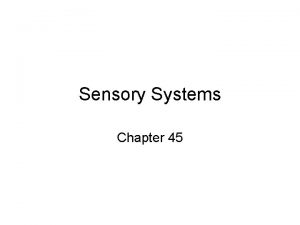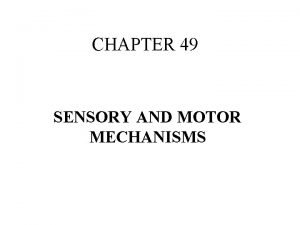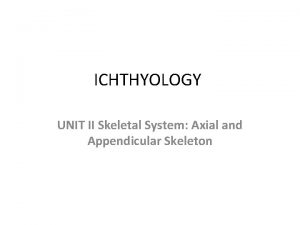ICHTHYOLOGY UNITIII Lateral Line System lateral line System














- Slides: 14

ICHTHYOLOGY UNIT-III Lateral Line System

lateral line System q The lateral line is a system of sense organs found in aquatic vertebrates, mainly fish, used to detect movement and vibration in the surrounding water. q The sensory ability is achieved via modified epithelial cells, hair cells or Neuromast, which respond to displacement caused by motion and transduce these signals into electrical impulses via excitatory synapses. q lines serve an important role in schooling behavior, predation, and orientation. For example, fish can use their lateral line system to follow the vortices produced by fleeing prey. Continue…. .

q. They are usually visible as faint lines running lengthwise down each side, from the vicinity of the gill covers to the base of the tail. q. In some species, the receptive organs of the lateral line have been modified to function as electroreceptors, which are organs used to detect electrical impulses, and as such these systems remain closely linked. q. Most amphibian larvae and some fully aquatic adult possess mechanosensitive systems comparable to the lateral line. [1] amphibians

Free sensory hillock (Neuromast)

Lateral line Khanna & Singh (2005) In fishes neuromast: �The ordinary lateral line organs which are mechanoreceptive and �The specialized type which are electroreceptive. �The ordinary type of neuromast are found in all fishes and may be superficial, scttered all over the body or in pits: but in actively swimming fishes, they are enclosed in canals.

Lateral line canal �The Lateral Line canal are arranged in definite pattern in the cephalic region. �A prominent Lateral Line canal extends along each side of the body from head to tail. �Several branches are present in the head region. �In teleost distribution of cephalic canal has become modified in various ways, such as loss of canals, development of new canals, change in the distribution etc. �This is also related to the mode of life and the environmental conditions of the species.

Cephalic canals of dog Fish (Scoliodon) A- Dorsal side; B- ventral side

Cephalic lateral canals in Amia

Lateral line canals in Wallago attu

Lteral Line canal in Notopterus chitala

Lteral Line canal in Hilsa ilisha and C. mrigala

Lateral line of teleost

Functions of Lateral Line �Mechan- reception in dark and turbid environment. Locate inanimate mobile or immobile objects with the help of neuromast. �Detecting food , prey avoiding predator for schooling and intraspecific communication. �Hydrodynamics Detection, of pressure created gradients or waves generated in water, act as distance touch receptor and fish can see an object at a distance in dark, muddy water

Thanks!!



























